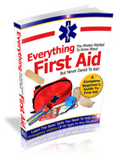Welcome to lacerations Guide
Face Lacerations Article
 To bookmark this article for further reading, click here.
To bookmark this article for further reading, click here.
Caring For Horse Lacerations
Horse enthusiasts know that to own horses is huge undertaking. Owners have a responsibility to take adequate care of them, which not only includes feeding them and corralling them, but they have to take care of their medical needs.
Horse lacerations are a major concern because they are frequently getting scraped up or cut on something. First aid for horses is just as important as it is for humans.
Horse lacerations come in many forms, from a cut from scratching one ankle with a hoof, to getting caught up in a barbed wire fence.
You might not be able to see at first glance just how deep horse lacerations go, until you examine the wounded area and begin to clean and treat it. To be able to treat horse lacerations, you need a well stocked emergency first aid kit.
In your horse first aid kit you will need a thermometer, stethoscope, gauze square bandages, and wrapping bandages.
You will need scissors, q-tips, zip-lock bags, vet wrap, hand towels, surgical tape, duct tape, and those chemical cold packs. If you don’t have the cold packs you can use a regular ice pack, or a frozen bag of peas works really well.
You will also need sterile saline, large syringes for irrigating wounds, Betadine, flash light, wire cutters, and topical ointments to name a few. Plainly visible on the first aid kit you should have your equine veterinarian’s office and after hours numbers.
You should never have to go hunting for the number, because time may be of the essence.
As with all injuries, horse lacerations can be quite serious; it is important to remain calm. If you panic you may not think of everything you need to do in an emergency.
Depending on where injury is, there might be heavy bleeding. Stop the flow of blood as quickly as you can. Place a hand towel over the wound and apply pressure until the bleeding slows to a stop.
Once the bleeding has stopped you may then begin to clean the wound. Your veterinarian may have a specific way that you are to proceed in wound care. Normally you may be asked to flush the horse lacerations with sterile saline.
When assessing horse lacerations you may need to determine just how deep a wound is. A good way to do that is to measure with a sterile q-tip, but if your horse is in a great deal of discomfort or anxiety over the situation, you may have to forgo that step.
You may not be able to adequately take care of the horse by yourself. It is advised to keep the numbers of neighbors and friends on hand to call in an emergency.
When horse lacerations are severe enough to need veterinary care, the owner will need to trailer the horse and take it to be examined and treated. You might need some help guiding the horse in the trailer.
Equine emergencies can leave the owner and the horse in a state of panic and anxiety. Having someone at your side to help you and the horse stay calm will get you on your way to the vet quickly and safely.


